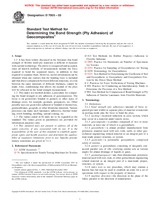Potřebujeme váš souhlas k využití jednotlivých dat, aby se vám mimo jiné mohly ukazovat informace týkající se vašich zájmů. Souhlas udělíte kliknutím na tlačítko „OK“.
ASTM D7005-03
Standard Test Method for Determining the Bond Strength (Ply Adhesion) of Geocomposites
Automaticky přeložený název:
Standardní zkušební metoda pro stanovení Soudržnost ( adheze) vrstev z geokompozita
NORMA vydána dne 1.12.2003
Informace o normě:
Označení normy: ASTM D7005-03
Poznámka: NEPLATNÁ
Datum vydání normy: 1.12.2003
Kód zboží: NS-37274
Počet stran: 3
Přibližná hmotnost: 9 g (0.02 liber)
Země: Americká technická norma
Kategorie: Technické normy ASTM
Anotace textu normy ASTM D7005-03 :
Keywords:
bond strength, geocomposite, laminates, ply adhesion strength, ICS Number Code 59.080.70 (Geotextiles)
Doplňující informace
| Significance and Use | ||||||||||
|
This test method is to be used as a quality control or quality assurance test. As a manufacturing quality control (MQC) test, it would generally be used by the geocomposite product manufacturer or fabricator. As a construction quality assurance (CQA) test, it would be used by certification or inspection organizations. This test method can also be used to verify if the adhesion or bond strength varies after exposure to various incubation media in durability and/or chemical resistance testing. Whatever use is to be associated with the test, it should be understood that this is an index test. Note 2—There have been numerous attempts to relate the results of this test to the interface shearing resistance of the respective materials determined per Test Method D 5321. To date, no relationships have been established between the two properties. Test Method D 7005 for determining the bond strength (ply adhesion) strength may be used as an acceptance test of commercial shipments of geocomposites, but caution is advised since information about between-laboratory precision is incomplete. Comparative tests as directed in 5.4.1 are advisable. In the case of a dispute arising from differences in reported test results when using the procedure in Test Method D 7005 for acceptance of commercial shipments, the purchaser and the supplier should first confirm that the tests were conducted using comparable test parameters including specimen conditioning, grip faces, grip size, etc. Comparative tests should then be conducted to determine if there is a statistical bias between their laboratories. Competent statistical assistance is recommended for the investigation of bias. As a minimum, the two parties should take a group of test specimens that are as homogeneous as possible and that are from a lot of the material in question. The test specimens should be randomly assigned to each laboratory for testing. The average results from the two laboratories should be compared to the Student's t-test for unpaired data and an acceptable probability level chosen by the two parties before the testing is begun. If a bias is found, either its cause must be found and corrected or the purchaser and supplier must agree to interpret future test results in the light of the known bias. Refer to Practice D 2905, Table 1. |
||||||||||
| 1. Scope | ||||||||||
|
1.1 It has been widely discussed in the literature that bond strength of flexible multi-ply materials is difficult to measure with current technology. The above is recognized and accepted, since all known methods of measurement include the force required to bend the separated layers, in addition to that required to separate them. However, useful information can be obtained when one realizes that the bending force is included and that direct comparison between different materials, or even between the same materials of different thickness, cannot be made. Also, conditioning that affects the moduli of the plies will be reflected in the bond strength measurement. 1.2 This index test method defines a procedure for comparing the bond strength or ply adhesion of geocomposites. The focus is on geotextiles bonded to geonets or other types of drainage cores; for example, geomats, geospacers, etc. Other possible uses are geotextiles adhered or bonded to themselves, geomembranes, geogrids, or other dissimilar materials. Various processes can make such laminates: adhesives, thermal bonding, stitch bonding, needling, spread coating, etc. 1.3 The values stated in SI units are to be regarded as the standard. The values given in parentheses are provided for information purposes only. 1.4 This standard does not purport to address all of the safety concerns, if any, associated with its use. It is the responsibility of the user of this standard to establish appropriate safety and health practices and determine the applicability of regulatory limitations prior to use. Specific precautionary statements are given in 7.1.1. |
||||||||||
| 2. Referenced Documents | ||||||||||
|




 Cookies
Cookies
